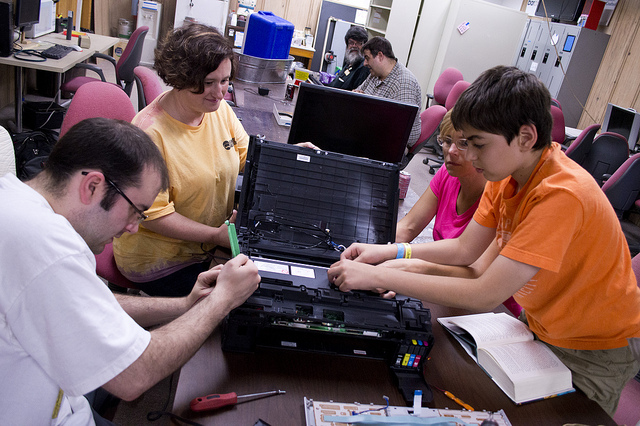
I attended a session at ASTC 2015 titled Are Maker Spaces Killing the Traditional Science Center? Is That a Bad Thing? and while I’m new to the museum world, I’m not new to the makerspace world, but this whole idea of “makerspace in another space” is what the session was about. This post is really just going to be a stream of my own thoughts after the session.
Hooley McLaughlin from the Ontario Science Centre was the moderator and he was anti-makerspace in the context of a science center, where (he believes) the real spark of science can be ignited in young minds. I don’t know much about science centers or the people who work there, but Hooley seems to place “science” (or perhaps just the teaching of science) in this ivory tower, and separate “Science” from other forms of exploration and discovery. The things than happen in a “tinkering” space or a “maker” space are not real science, and there isn’t true learning.
I’ve been involved with Milwaukee Makerspace for nearly five years, and before that I was part of Bucketworks, which is/was a quasi-hackerspace, and I’ve had this idea that BAMspace at Betty Brinn Children’s Museum) Makerspaces tend to be open 24 hours a day, 7 days a week, with everything available to members at any time. 6am on Sunday morning? 3pm on a weekday? Saturday night from 10pm to 4am? Those are all valid times to be at a makerspace working on things. Spaces in an institution are typically limited by staffing, just having people available to be in charge of things. And people like to go home and sleep every now and then, and not work 24 hours a day… also, when people do work, they like to get paid. So the first big disconnect is “makerspace open all the time to members who are self-serving” versus “makerspace that is available during only specific times with staff to guide things.” I’m not saying the second option can’t work, it can, but for people who know what a makerspace is as it exists outside of an institution, reconciling how they operate inside an institution may difficult.
Perhaps it’s just a matter of managing expectations. If the first exposure to a makerspace is within an institution, that can set the stage for what one is, and how it works. (There’s the issue of the term “makerspace” being co-opted or misunderstood, but I won’t get into that now.) Limited access due to hours, staffing, etc. can definitely affect the reach of a space/program, but as most of the institutional makerspaces seem to focus on kids (or families) maybe it’s a non-issue.
Ultimately, my favorite comment during the session pretty much summed things up. “We shouldn’t care how kids get interested in science, as long as they get interested.” My own take on that is, I try things, and make things, and fail, and learn, and in the end, I share those things. I share them with others, and if they get inspired, even just a small bit, than it’s a success. If someone gets interested in robotics, or looks up what an Arduino is, or asks a question about 3D printers, then that’s good enough for me. It’s a spark, and a spark is the start of something. It may not be the spark that (certain) people at science centers are hoping for, but it’s a success in my book.

















